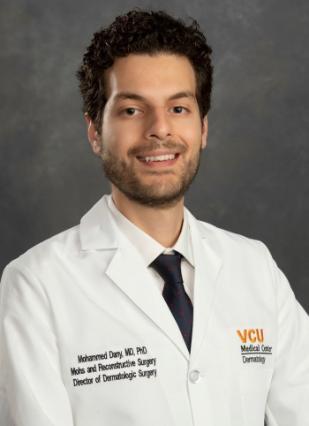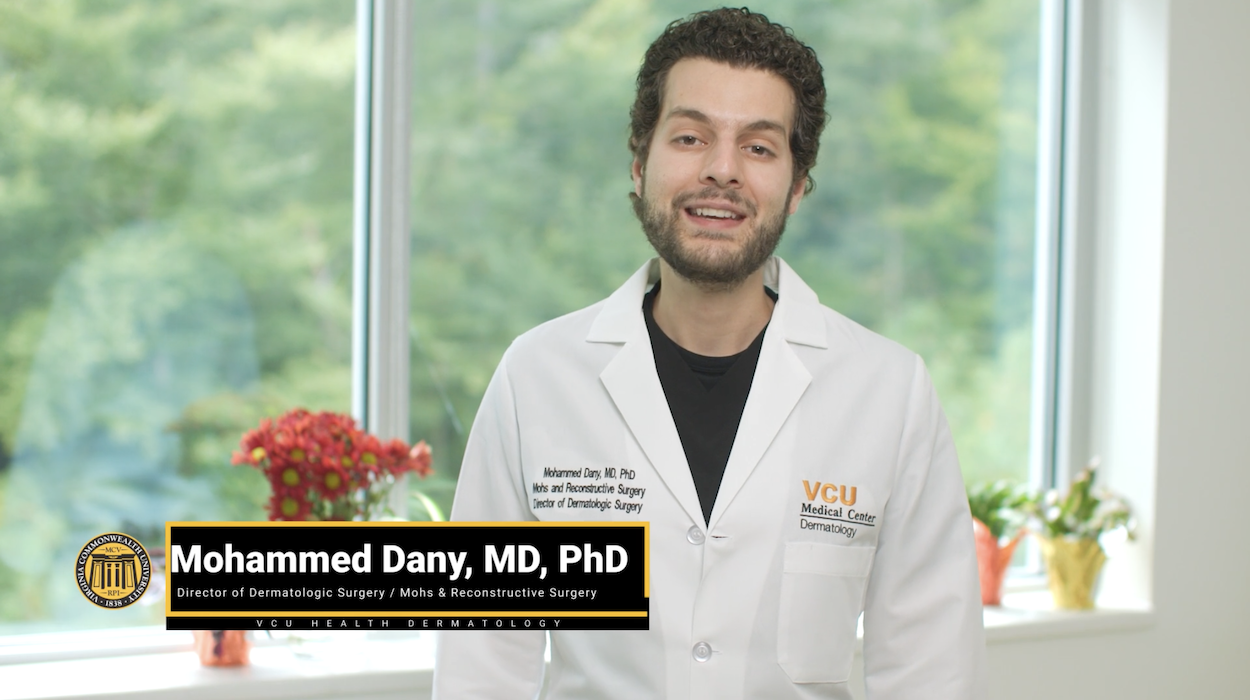Dermatology at VCU Health and Massey Comprehensive Cancer Center
Our dermatologists provide specialty care for the diagnosis and treatment of a range of common and more complex conditions related to the skin, hair, nails and mucous membranes.
Our team of specialists are highly skilled, focusing attention on the most medically advance research and dermatologic treatments. As part of an academic medical center and the only National Cancer Institute-designated Cancer Center in Richmond, VCU Massey Comprehensive Cancer Center, our Mohs micrographic surgeons are part of a comprehensive team uniquely trained to treat skin cancer through highly specialized care and diagnostic services.
Skin Cancer
What causes skin cancer?
According to the American Cancer Society, each year approximately 3.3 million people develop skin cancer in the United States. There are many factors that contribute to the formation of skin cancers; however, the most important factor is sun exposure. Some patients can develop skin cancer in areas of the body that are no sun exposed, providing evidence that some skin cancers are genetically determined. Other causes of skin cancer include chronic infections, x-ray exposure, trauma and injury and a compromised immune system.
Why should skin cancers be removed?
Skin cancers represent cells that undergo predictable growth patterns. The two most common types of skin cancer are basal cell carcinoma and squamous cell carcinoma. Basal cell carcinomas grow slowly. If left untreated, they may grow rather large, ulcerate and become locally destructive and disfiguring. Only rarely does basal cell carcinoma spread throughout the body. Squamous cell carcinomas are more aggressive and have the potential to spread to other areas of the body. In order to prevent the cancer from spreading, it is important to have the identified skin areas removed.
What is Mohs Surgery?
Developed by Dr. Frederic Mohs in 1938, Mohs surgery is the most advanced and effective treatment for skin cancer, providing a cure rate of up to 99%. Because the Mohs technique involves one physician who acts as a surgeon, pathologist and reconstructive surgeon, additional specialty training is necessary to practice Mohs micrographic surgery. In the first part of the procedure, the surgeon removes the affected skin, which includes the visible portion of the legion. Immediately after, the surgeon examines the tissue under a microscope.
If the tissue examination shows the possibility of skin cancer remaining, the physician will remove additional skin. This process will be repeated until there is no remaining diseased tissue. Finally, the physician will reconstruct the area of the procedure, which may include sutures, skin flaps or grafts. Mohs micrographic surgery allows the surgeon to remove only the cancerous tissue, minimizing the defect and promoting the best cosmetic results. Because of this benefit, Mohs is the preferred treatment for lesions of the face, ears and other sensitive areas.
Preparation
When your procedure is scheduled, a packet of information will be sent to you. Some patients may be seen in our office prior to surgery, but most patients will be contacted by telephone to gather important health information. A list of questions you will be asked is included in the packet. When you receive it, please review the questions and be prepared to answer them when the interviewer calls.
Surgery, Postoperative Expectations, and Healing
Our key concerns include:
- Your current medications
- Are you taking blood thinners (aspirin, ibuprofen, Coumadin or Plavix) or any medication that will affect blood clotting and wound healing?
- Are you taking non-medication supplements or vitamins?
- Do you have a pacemaker, defibrillator or implantable device (deep brain stimulator, cochlear implant)?
On the day of the surgery, you should take any routing medications prescribed to you, such as high blood pressure medication. You should discontinue use of vitamins or supplements 10 days prior to the procedure. Also, make plans with a relative or friend to accompany you and drive you home after the surgery.
What should I expect on the day of surgery?
The Mohs micrographic surgery procedure is performed outpatient and under local anesthesia. Photographs of the surgical site will be taken before, during and after the procedure. You should plan to spend all day at the clinic, so please bring reading material or other entertainment, wear comfortable clothes, eat a good breakfast and bring a lunch and snack.
What happens once surgery is completed?
The hole created by the procedure can heal in a variety of ways. It can be left to heal on its own (called secondary intention) or a reconstructive procedure with stitches may be required for closure. The final determination of the best reconstructive procedure will be made once the cancer has been completely removed using the Mohs technique.
Healing by secondary intention (healing naturally)
Second intention wound healing describes the method of natural healing with daily care. Depending on the size and location of the wound, it may take from three weeks to six weeks for it to heal. Wounds that are allowed to heal by this method may initially have a mild to moderate amount of clear drainage. The base of the wound will be red initially, but may become somewhat gray or yellow in appearance. Detailed written and verbal wound care instructions will be provided following the surgery.
Closed wounds (sutures, flaps or grafts)
Your wound may be closed with sutures (stitches) and/or skin flaps or skin grafts. Follow-up care will be arranged by your physician. Sutures are generally removed five to seven days following surgery.
Pain, bleeding, bruising
Pain after surgery varies based on location and extent of the procedure. Most discomfort can be controlled with Tylenol. Bleeding may continue after the wound is dressed. Avoid activities such as bending and lifting after surgery, as they may increase the likelihood of bleeding. If bleeding does occur, the wound dressing may become saturated and should be removed. If there is still active bleeding, apply firm, steady pressure continuously for 20 minutes at the base of the wound with a clean cloth.
If bleeding does not stop, you should contact the office at (804) 327-8150 Monday through Friday from 8am-5pm. If you have concerns outside of regular office hours, please leave a message for the physician on-call at (804) 628-MOHS (6647).
Swelling and bruising may develop shortly after surgery, especially when the surgery is performed on areas near the eyes such as the forehead and nose. Most patients will have a follow-up appointment approximately 1-2 weeks after their surgery. Avoid physical exertion, heavy lifting, exercising at the gym, swimming and doing cardio exercises for at least one week after surgery. Please do not travel one week after surgery.
Will there be a scar?
Yes. There is no form of surgery that does not leave a scar. However, the tissue-sparing nature of Mohs micrographic surgery minimizes scarring.
Meet Our Physician
Mohammed Dany, MD, PhD
Mohammed Dany, MD, PhD, is the Director of Mohs and Dermatologic Surgery and the Director of Cosmetics and Laser Surgery for the Department of Dermatology at VCU Health. After receiving his medical degree from the Medical University of South Carolina, Dr. Dany completed an internship at Harvard Medical School/Brigham & Women’s Hospital. He then completed his residency in Dermatology at the University of Pennsylvania School of Medicine. Dr. Dany received his training in Mohs Micrographic and Reconstructive Surgery during his fellowship at the New York University Grossman School of Medicine.

Dr. Dany is a board-certified dermatologist and is one of only a handful of Mohs surgeons in the greater Richmond area. He is also a cutaneous oncologist, treating patients with rare tumors such as Merkle cell carcinoma, sebaceous carcinoma and Dermatofibrosarcoma protuberans. His commitment to accuracy extends to cosmetic and laser surgery, where he enhances his patients' self-esteem through various procedures, including neurotoxin injections, hyaluronic acid filler injections and advanced laser treatments. Dr. Dany is also an active researcher in the dermatologic field, with a particular interest in integrating molecular biology into the staging of skin cancers and identifying biomarkers that predict patient outcomes.
Our Team
During your surgical visit, you will meet your surgeon and their team, which consists of nurses, histotechnicians, a scheduler, and possibly a fellow, who is a dermatologist seeking additional training in Mohs surgery. All of these individuals work together to assure that you receive the highest quality care.
VCU Health at Stony Point provides a dermatologic office equipped for our Mohs micrographic surgery procedures. In addition, our dedicated laboratory, which processes only our pathology specimens, has achieved accreditation through the College of American Pathologists (CAP).
Referral Information
The following information is needed for referrals:
- patient demographics
- last office visit note
- pathology report
- color photo of biopsy site
Contact information:
- Rebecca Riley, RN - Mohs Triage Nurse
Contact Us
VCU Health Dermatology at Stony Point 9109
9109 Stony Point Parkway
Richmond, VA 23235

Office: (804) 327-8150
Monday-Friday, 8am-5pm
After hours: (804) 628-MOHS (6647)
If you have questions or concerns outside of regular office hours, please leave a message for the physician on-call.
